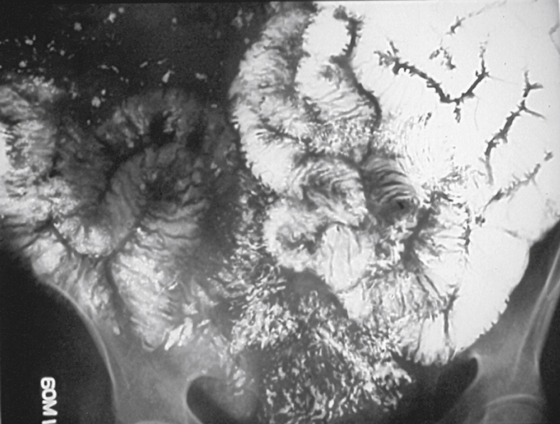CASE 48

History: A 27-year-old woman presents with diarrhea.
1. Which of the following should be included in the differential diagnosis of the imaging finding shown in the figure? (Choose all that apply.)
2. The figure shows the loops of distal ileum in the right abdomen displaying a fold density equal to or greater than that seen in the loops of jejunum in the left abdomen. What is the name and significance of this observation?
D. None, this is a normal variant
3. A sign on barium small bowel follow-through indicating malabsorption is described as “the barium forming smooth featureless elongated columns or clumps in the jejunum.” What is the name of this sign?
4. What is the most common abnormality seen on barium small bowel studies in patients with celiac disease?
ANSWERS
CASE 48
Small Bowel Malabsorption
1. A, B, C, and D
2. B
3. D
4. D
References
Maglinte DD, Kelvin FM, O’Connor K, et al: Current status of small bowel radiography. Abdom Imaging. 1996;21:247–257.
Cross-Reference
Gastrointestinal Imaging: THE REQUISITES, 3rd ed, pp 111-114.
Comment
There can be degrees of malabsorption seen in patients with diarrhea and various food intolerances. The best known of these is celiac disease, a form of gluten intolerance (also known as nontropical sprue). There appear to be varying degrees of intolerance. The cases that come to medical attention are in patients suffering from diarrhea, steatorrhea, and weight loss. The definitive diagnostic examination is small endoscopy with mucosal biopsy. Even with small ingested video capsules that can traverse the small bowel and provide video of the mucosal surface, the barium small bowel follow-through is the fastest and least expensive way of making a diagnosis. Patients with symptoms serious enough to motivate them to seek medical attention almost always have some or all of the findings of malabsorption on the barium examination (see figure). The classic appearance of flocculation, segmentation, and the famous moulage sign are infrequently seen owing to the continued improvement of modern barium suspensions. What is seen is dilation of bowel, atrophy and effacement of the fold pattern, particularly in the ileum, and hypersecretion.







